Bodega Bay
Driving north up the coast from the Golden Gate Gate Bridge you pass Point Reyes National Seashore, then you find yourself driving along the shore of Tomales Bay, a long and narrow inlet. This is no ordinary inlet, it is the San Andreas Fault. Beyond the mouth of the bay you come to the town of Bodega Bay which is sheltered from the Pacific by Bodega Head. Well, it is at the moment, but the town is on the North American Plate and the head is on the Pacific Plate so they are gradually moving apart. Once a Russian trading post, Bodega Bay is most famous as the setting for the Alfred Hitchcock movie, The Birds.
View south down coast from near Elk
Unlike the Big Sur area of the Californian coast, there are a few towns along this section of Route 1. Between the towns you can see the sea much of the time that you are driving along, but stopping points are not as plentiful as they are along Big Sur. However, where you can stop to take in the view it is very worthwhile.
North Central Coast
While the coast from Monterey to San Francisco is relatively built up, from San Francisco you need only go over the Golden Gate Bridge to pick up the Route 1 again and find yourself in open country. This section covers the coast from the north of the Golden Gate Bridge up to Mendocino which is about half way between San Francisco and the Oregon border. This part of the coast is nowhere near as famous as Big Sur, but we think is is just as good.
DLU100531
Click on Minimap to navigate
Home > US States > The West > California > Californian Coast >

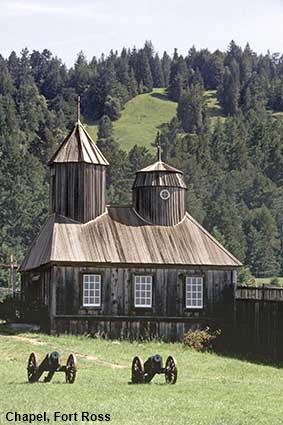
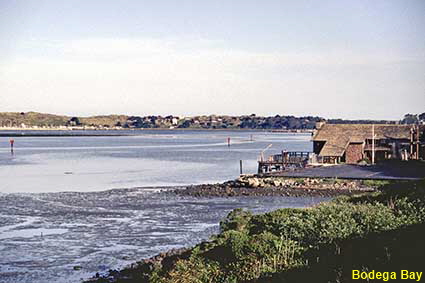
Log on beach, Sonoma Coast State Beach
Sonoma Coast State Beach runs either side of the mouth of the Russian River, including a peninsula formed by a bend in the river. The coastal scenery here is enhanced by a liberal sprinkling of rocks jutting out of the ocean. Further north in Oregon and Washington, the beaches are strewn with tree trunks that have escaped from the logging industry. This one appears to have gone on a longer journey than most.
Main Street, Mendocino
Mendocino sits on a peninsula jutting out into the Pacific. It was founded in 1850 as a logging community and was originally called Meiggsville. The town has an ‘olde worlde’ feel, the people here are proud that there are no supermarkets, fast food chains or motels. It is renowned for its wooden water towers that stand alongside or on top of many buildings, a reminder that potable water is a precious resource here. The location and atmosphere of Mendocino has attracted many artists and it has been used as a location for TV shows and movies. The TV series ‘Murder, She Wrote’ used shots of Mendocino to create the fictional town of Cabot Cove, Maine. Did nobody notice that the weather in Cabot Cove was distinctly untypical for Maine? Click Tab 2 to see the water tower alongside the Kelley House Museum.

Chapel at Fort Ross
Within eight years of Fort Ross being established the sea otters had been hunted close to extinction. In 1839 the Russian-American Company that owned Fort Ross signed an agreement with the Hudson’s Bay Company that ensured the supply of their main Alaskan base at Sitka, making Fort Ross largely redundant. In 1841 the fort was sold to John Sutter of New Helvetia in the Sacramento Valley, and the Russians left. Sutter dismantled and removed many of the buildings at Fort Ross. In 1906 the site was purchased by the State of California who set up Fort Ross State Historic Park. The buildings remaining on site were renovated and some that had been removed were reconstructed. The Russian Chapel, shown here, collapsed in the 1906 San Francisco earthquake but was rebuilt in 1916 using much of the original timber.
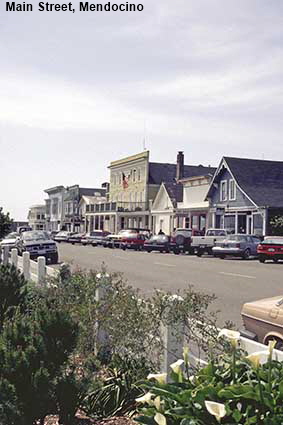
Fort Ross & giant Eucaliptus trees
Although California used to be Spanish territory, the Russians once also had a presence here. Drawn by the fur that could be obtained from marine mammals, from 1784 the Russians settled on the coast of Alaska and from there they roamed as far south as Baja California, now in Mexico. In 1812 San Francisco was the northern limit of Spanish settlement so the Russians decided to build a colony called Fort Ross on the coast north of San Francisco. It was a base for hunting marine mammals such as sea otters, for growing crops to support the Russian settlements in Alaska and to trade with Spanish California.
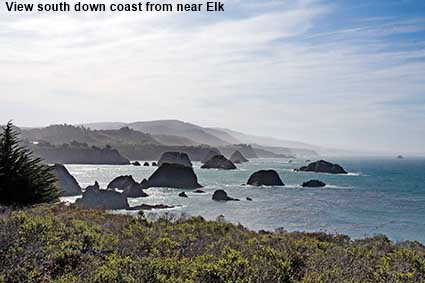
Point Arena Lighthouse
A rocky point jutting out into the pacific Ocean is a good place to build a lighthouse, except when that point is right next to the San Andreas Fault. Point Arena Lighthouse was constructed in 1870 but the 1906 earthquake that destroyed much of San Francisco damaged the lighthouse and its keeper’s house beyond repair. A new, earthquake resistant lighthouse was opened in 1908. The light was replaced by an automated beacon in 1977. Point Arena Lighthouse is now open as a tourist attraction and you can climb to the top of the 35 metre (115 foot) high tower. The former keepers’ houses, on the right of the picture are let as holiday accommodation.
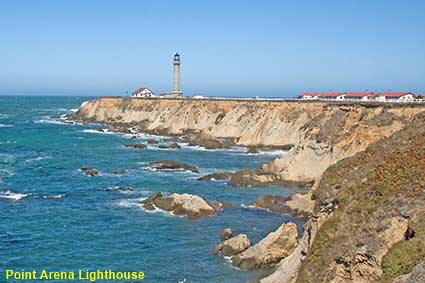


To move forwards or backwards through the California Coast trail click the arrows above, or select your next destination on the Minimap.
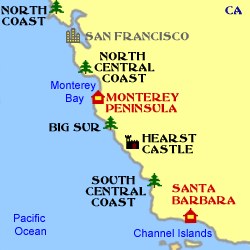

© Mike Elsden 1981 - 2025
The contents of this page may not be reproduced in full or in part without permission